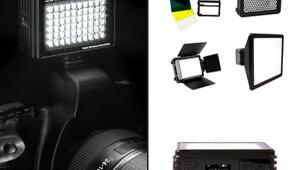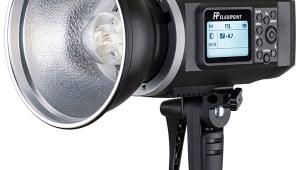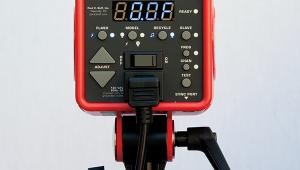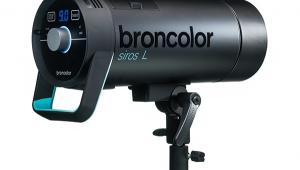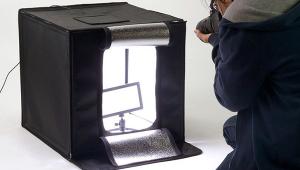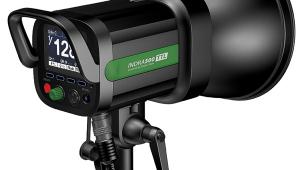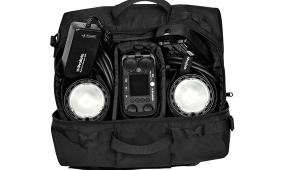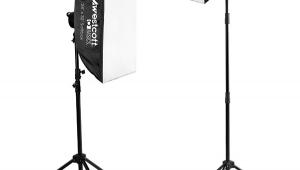Einstein Studio Light: An Affordable Monobloc With Power & Features
The Einstein monobloc strobe is listed at 640 watt seconds (ws) of power, has a bright 250-watt modeling light that can vary proportionally with the flash output, a 12 flash per second (fps) claimed capability, and a constant 5600˚K color temperature, no matter what the power level. Also, a claimed nine f/stop range, from 2.5 to 640 ws, and Paul C. Buff’s proprietary IGBT technology fill out the bill. It’s solidly built, using a Lexan housing instead of metal. It’s not very big, but is bigger and about a pound heavier than the company’s AlienBees units that many photographers, including myself, use.


After unpacking and placing on a light stand, the first thing you’re going to notice is that colorful display on the back. No, it’s not a video game. It’s a sophisticated control panel that immediately makes you feel all your older lights are outdated. It has a Function button that basically allows you to scroll through the different settings and make adjustments with the up and down keys. This keeps the back of the light very clean and uncluttered, with the only visible controls being the display, up and down arrows, a Power button, a Test button, and an “Easy Set” button. The optical slave is wisely placed on top of the unit so it can sense light from any direction.
You can see there is no shortage of either features or power here, so I first did some technical testing to check out just how accurate the specs were and then did several test shoots with models to see how Einstein performed in the studio.

All Photos © Steve Bedell
Let’s look at power first and what you can do with it. Gone are the days (for most of us) of ISO 25 to 100 film. Today’s cameras easily deliver quality images at ISOs we only dreamed of years ago. This means that for most of us, 2400 ws power packs are now dinosaurs. My pet peeve is not that flash units do not have enough power, but many have plenty of power on the top end but don’t allow you to power them down enough on the low end. If you’re asking yourself why this is important, I like having the ability to shoot at larger f/stops in my small studio. This allows me to throw backgrounds out of focus without needing 6 feet behind my subject. With 640 ws of power and the ability to dial it down so much that my flash meter couldn’t even read it at 10 feet, I’d say Einstein has both ends pretty well covered. But is it really accurate?
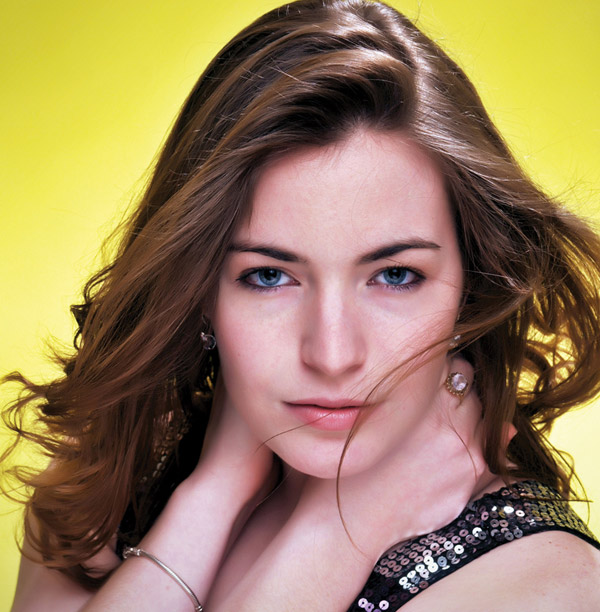
I had to change my test procedure for the lower end. I usually mark off 10 feet and check power output at the different levels to see if the output is behaving the way it should, or at least how the manufacturers claim. Since 10 feet was too far to register that little 2.5 ws burst of light, I moved closer until I was able to register f/2 then kept bumping up a stop all the way up to a blinding f/32. I found Einstein deadly accurate at all power levels. As a side note, this unit is of course compatible with Buff’s Cyber Commander system that allows you to instantly change flash power settings from camera position. Having a nine f/stop range at your fingertips is true bliss for studio photographers who appreciate precise control.
Like many European units, Einstein offers control in 1⁄10 f/stop units. Want a stop less light? Just click down 10 clicks on the clearly marked power output graph. Too much? Knock it back up a couple of tenths with a couple of clicks. It’s simple, and in my testing, extremely accurate. Speaking of Europe, Einstein is so smart that when you plug him in, he doesn’t care if it’s an American or European current, he’ll figure it out by himself, thank you.

And while we’re on the subject of being smart, let’s take a look at the IGBT flash tube control. Many inexpensive flash units, Buff’s included, have long had an issue with critical color temperature. This is because when you change the power output on most flash units the flash duration also changes, which affects the color. Einstein offers you a couple of choices. Select Color from the display panel and the IGBT technology will control the flash so that the color is consistent.
If you need to shoot in rapid fire mode and quick recycle is more important to you than precise color control, select Action. Even in the Action mode, I shot at 4 fps in the studio without discernible color shift.
One of the reasons Einstein was delivered to my door in such a small box is that it comes with no supplied reflector. Instead, it comes with a Pyrex diffusing dome. This snaps into place over the flash tube and, according to the manufacturer, protects the flash tube and also reduces UV output. I used a standard 8.5” reflector for some of my testing but most of my shooting was with the Buff PLM light modifiers.

Returning to the Easy Set button, pressing that lets the unit default to the most popular settings and then allows the user to fine-tune the settings with the Function feature. By pressing the Easy Set button the modeling light tracks the flash power, the slave sensor is turned on, Color mode is selected, and both the ready light and beeper function. A microSD card slot allows for future firmware upgrades for this computer masquerading as a professional studio flash.
That’s all the good stuff. Complaints? Even though the method to change reflectors and light boxes has been upgraded to a lever you press down from the two prongs you squeeze together, it’s still a little awkward when changing light modifiers and I once even burned my hand on the hot metal adapter on the PLM modifiers. And the prongs that hold the Pyrex diffuser are awfully close to and similar to the prongs that you mount the reflectors on.
Conclusion
This is state-of-the-art technology that does what more expensive brands do and more, and at a price no one else comes close to ($499.95, MSRP). Couple this with a Cyber Commander unit and a Vagabond battery and you’ve got unmatched power and versatility either in the studio or on location. If you’re looking for an affordable yet feature-rich monobloc, I’d put Einstein at the top of your shopping list.
For more information, contact Paul C. Buff, Inc. at: www.paulcbuff.com.
Steve Bedell has been a portrait photographer for over 25 years. To subscribe to EPhoto, a free e-mail newsletter with tips for photographers, contact Bedell via e-mail at: sb@stevebedell.com. Also ask about his lighting DVDs.
- Log in or register to post comments


